Poste Italiane Bundle
How has the Italian Post Office, Poste Italiane, evolved through time?
Journey back in time to explore the fascinating Poste Italiane SWOT Analysis and its pivotal role in shaping Italy. From its humble beginnings as 'Regie Poste' in 1862, just after Italian unification, to its current status as a diversified financial powerhouse, the story of Poste Italiane is a captivating narrative of national development and strategic adaptation. Discover how the Italian postal service transformed, reflecting the nation's growth and embracing technological advancements.
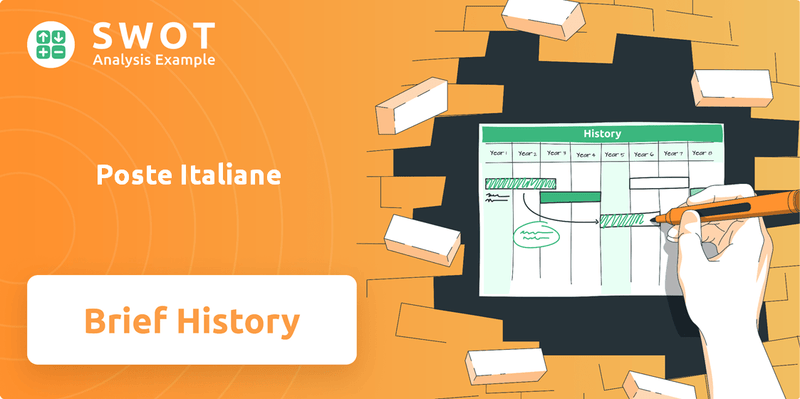
The History of Poste Italiane highlights the Italian Post Office's journey from a unified postal service to a multifaceted enterprise. Initially designed to connect the newly formed kingdom, the company's evolution mirrors Italy's own transformation. Today, Poste Italiane stands as a testament to adaptability, boasting impressive financial results and a strong market position, underscoring its continued significance in Italian society and its role in the Italian postal service.
What is the Poste Italiane Founding Story?
The History of Poste Italiane, formerly known as the Italian Post Office, began on May 5, 1862. This marked the official establishment of the 'Regie Poste' through Law 604, also known as the 'Postal reform'. This reform was crucial for unifying the postal services across the newly formed Kingdom of Italy.
The primary goal was to create a unified postal system, addressing the fragmented communication infrastructure that hindered national integration and efficient commerce. This initiative was a governmental effort to establish a cohesive national infrastructure, essential for Italy's unification in 1861.
The initial business model revolved around providing a universal postal service, facilitating communication and commerce throughout Italy. The first service offered was the standardized postal service, enabled by the introduction of postal stamps. In 1889, the Directorate General of Posts and Telegraphs was separated from the Ministry of Public Works, becoming the Ministry of Posts and Telegraphs, highlighting the growing importance of the Italian postal service.
The establishment of the 'Regie Poste' in 1862 marked the beginning of a unified Italian postal service.
- The 'Postal reform' aimed to integrate fragmented postal services.
- The Ministry of Posts and Telegraphs was created in 1889, emphasizing the growing importance of the postal service.
- The introduction of postal stamps standardized postal services.
- The unification of Italy in 1861 provided the impetus for postal reform.
Poste Italiane SWOT Analysis
- Complete SWOT Breakdown
- Fully Customizable
- Editable in Excel & Word
- Professional Formatting
- Investor-Ready Format
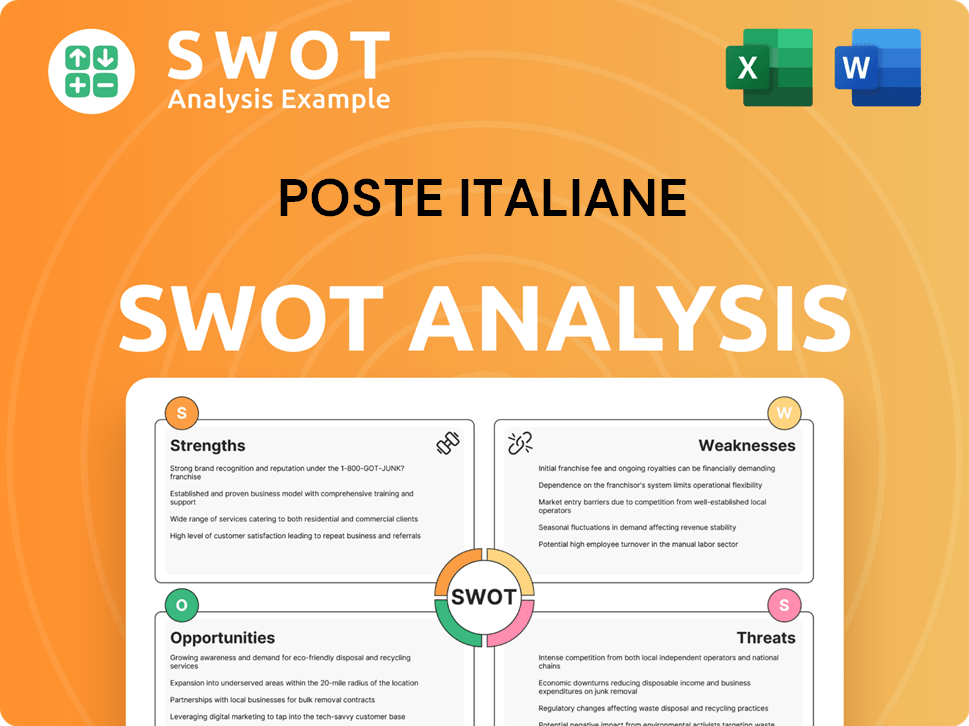
What Drove the Early Growth of Poste Italiane?
The early growth and expansion of the Italian Post Office, known initially as 'Regie Poste,' focused on extending its services across the newly unified Italy. This phase involved significant infrastructural developments and the broadening of service offerings beyond traditional mail. A key milestone was the introduction of parcel post in 1881, which soon evolved to include home delivery, showcasing an early adaptation to modern delivery practices. The Italian postal service's structure was also refined during this period.
The launch of the parcel post service in 1881 was a critical step in the History of Poste Italiane. Initially, parcels needed to be collected from post offices, but the service quickly transitioned to home delivery. This early adoption of home delivery demonstrated the company's foresight in anticipating future logistical demands.
By 1909, the postal and telegraphic services were consolidated and relocated to dedicated headquarters. This move streamlined operations and improved efficiency. This strategic consolidation was vital for managing the expanding network and services of the Italian Post Office.
The late 20th and early 21st centuries marked a significant diversification phase for Poste Italiane. In 1996, the company transitioned into a state-owned business (Società per Azioni), setting the stage for modernization. This period also saw the appointment of Corrado Passera as CEO in February 1998, which further accelerated these changes.
Poste Italiane expanded its services to include express courier services with SDA Express Courier, digital services through Postecom, financial products via BancoPosta Fondi, and hybrid electronic mail processing with Postel. The establishment of Poste Assicura in 2010 broadened its financial services portfolio. A key acquisition in 2011 was UniCredit MedioCredito Centrale, which strengthened its financial services arm.
Poste Italiane embraced an integrated and omnichannel approach, leveraging technology to enhance the customer experience. This strategic evolution led to the company's public listing on the Milan Stock Exchange in 2015. The Italian government continues to control the company, reflecting its role as a public service provider. For more details, see the Revenue Streams & Business Model of Poste Italiane.
The listing on the stock exchange and the transfer of shares to Cassa Depositi e Prestiti in 2016 highlighted a move towards a more market-oriented structure. By 2025, Poste Italiane had approximately 3.3 billion digital interactions annually and 97 million financial app downloads, demonstrating its commitment to digital transformation. This transformation has helped the company evolve from a postal service into a multifaceted organization.
Poste Italiane PESTLE Analysis
- Covers All 6 PESTLE Categories
- No Research Needed – Save Hours of Work
- Built by Experts, Trusted by Consultants
- Instant Download, Ready to Use
- 100% Editable, Fully Customizable
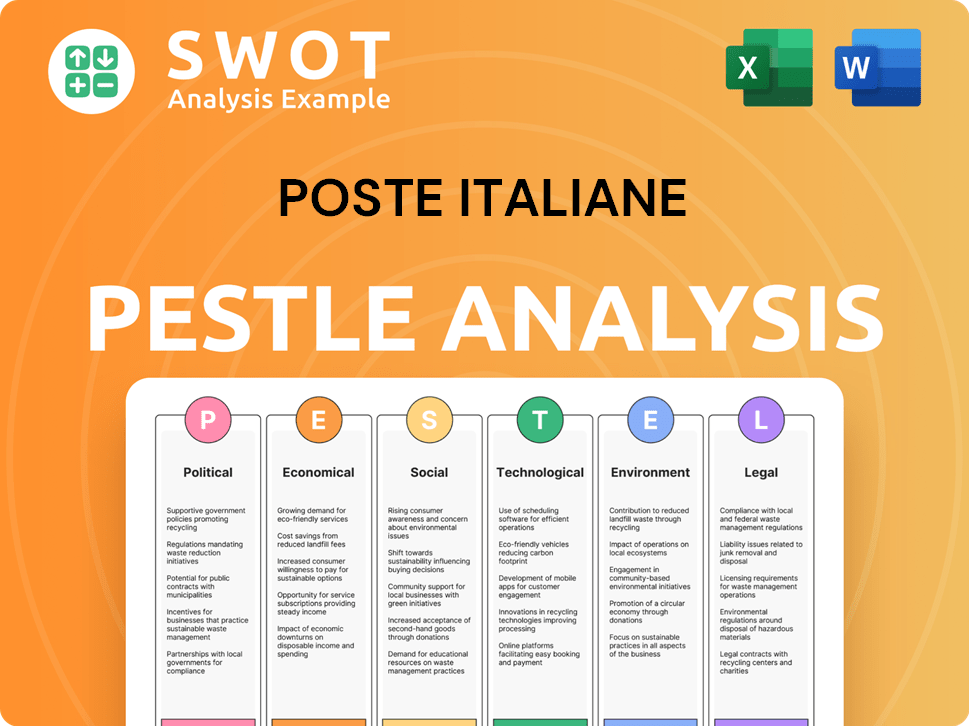
What are the key Milestones in Poste Italiane history?
The History of Poste Italiane is marked by significant milestones, reflecting its evolution from a traditional postal service to a multifaceted financial and digital services provider. These achievements highlight its adaptability and its crucial role in Italy's economic and social development.
| Year | Milestone |
|---|---|
| Early Years | The Italian postal service was established, laying the foundation for what would become Poste Italiane. |
| Recent Years | Focused on transforming its logistics network to become a full-fledged end-to-end logistics operator, particularly in parcel management. |
| 2023 | Achieved breakeven point for its Mail, Parcels, and Distribution segment, a year ahead of schedule. |
| 2024 | Achieved record-breaking revenues of €12.6 billion and a net profit of €2 billion. |
| March 2025 | The company's commitment to sustainability was recognized with the 'Sustainability Report' award for the second consecutive year. |
Poste Italiane has consistently embraced innovation, transforming its operations and services to meet evolving market demands. A key innovation is its 'SuperApp,' leveraging AI to provide a central access point to its ecosystem, boosting cross-selling and up-selling opportunities.
The company has proactively embraced digital transformation, evidenced by its current standing as Italy's largest digital platform.
Development of a 'SuperApp' that leverages AI to provide a unique access point to Poste Italiane's ecosystem.
Focused on transforming its logistics network to become a full-fledged end-to-end logistics operator, increasingly oriented towards parcel management.
Significant strides in sustainability, integrating ESG principles into its business strategy, with a goal of carbon neutrality by 2030.
The 'Polis Project' is a notable initiative to support social cohesion and reduce the digital divide in small municipalities.
Financial services segment has been a standout performer, with gross revenues increasing by 7% to €1,670 million and adjusted EBIT surging by 31% to €260 million in Q1 2025.
Despite its successes, Poste Italiane has faced challenges, including the decline in traditional mail volumes and competitive pressures. However, the company has demonstrated resilience, adapting to market changes and maintaining strong financial performance.
Adapting to the structural decline in traditional mail volumes due to digital communication is a significant challenge.
The company has also faced market downturns and competitive threats, particularly in the competitive logistics market.
The shift towards parcel management is a response to the growth of e-commerce, requiring significant investment and operational adjustments.
Navigating regulatory changes and economic fluctuations presents ongoing challenges for the company.
Ensuring profitability in a changing market environment requires continuous cost management and strategic initiatives.
Facing competition in financial services from both traditional banks and fintech companies.
Poste Italiane Business Model Canvas
- Complete 9-Block Business Model Canvas
- Effortlessly Communicate Your Business Strategy
- Investor-Ready BMC Format
- 100% Editable and Customizable
- Clear and Structured Layout
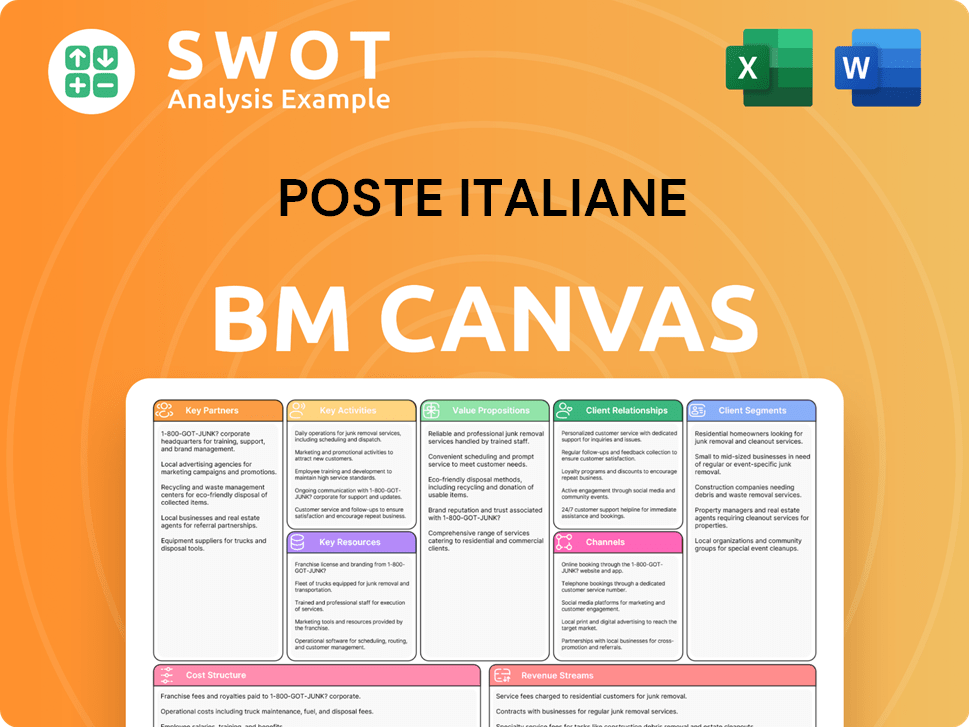
What is the Timeline of Key Events for Poste Italiane?
The History of Poste Italiane, or the Italian Post Office, is marked by significant transformations that have shaped its current strategic direction, evolving from a unified postal service to a diversified company offering financial, insurance, and logistics services.
| Year | Key Event |
|---|---|
| 1862 | Founding of 'Regie Poste' on May 5, establishing a unified postal service in Italy. |
| 1881 | Launch of the parcel post service, initially for pickup and later expanding to home delivery. |
| 1889 | Separation of the Directorate General of Posts and Telegraphs from the Ministry of Public Works, forming the Ministry of Posts and Telegraphs. |
| 1996 | Transformation into a state-owned business (Società per Azioni). |
| 1998 | Appointment of Corrado Passera as CEO, signaling a new era of modernization and diversification. |
| 2010 | Establishment of Poste Assicura for non-life insurance services. |
| 2011 | Acquisition of UniCredit MedioCredito Centrale, strengthening financial services. |
| 2015 | Listing on the Milan Stock Exchange. |
| 2021 | Launch of the '2024 Sustain & Innovate' strategic plan, focusing on sustainable growth and digital shift. |
| 2023 | Mail, Parcels, and Distribution segment reaches breakeven point, one year ahead of schedule. |
| 2024 | Record-breaking revenues of €12.6 billion and net profit of €2.0 billion. |
| March 2024 | Presentation of the '2024-2028 Strategic Plan – The Connecting Platform,' emphasizing logistics transformation, a new commercial service model, and the 'Polis Project.' |
| March 2025 | Wins 'Sustainability Report' award for the second consecutive year. |
| March 2025 | Poste Italiane's Total Financial Assets (TFA) reach €596 billion. |
| May 2025 | Acquires an additional 15% of TIM ordinary shares, bringing its total stake to 24.81%, aiming to support consolidation in the Italian telecommunications market. |
The company aims to become a fully-fledged end-to-end logistics operator, transforming the postal network to be increasingly parcel-focused. This involves developing a joint venture with a specialized logistics real-estate partner and expanding warehouse capacity to 400,000 square meters by 2028 from 230,000 in 2023. Delivery services are expected to include micro-fulfillment options allowing for deliveries within 4 hours.
Poste Italiane is heavily investing in technology, including AI, to enhance customer experience. The SuperApp, incorporating a new payment wallet, will be customized to individual client profiles, serving as a unique access point to the company's ecosystem.
This initiative continues to bridge the digital divide and support social cohesion by transforming approximately 7,000 post offices in small municipalities into digital service hubs by 2026, offering quick and easy access to public administration services.
The company anticipates continued strong performance in these segments, with Total Financial Assets (TFA) projected to grow to €624 billion by 2028. The strategic investment in TIM is expected to generate synergies, allowing Postepay access to TIM's mobile network infrastructure starting January 1, 2026, and expanding offerings into high-margin telecom services.
Poste Italiane is committed to achieving carbon neutrality by 2030 and integrating ESG principles across its operations.
The company projects continued growth, with adjusted EBIT guidance of €3.1 billion and net profit guidance of €2.1 billion for 2025. Poste Italiane is reinforcing its dividend policy, with a payout ratio structurally increased to 70% throughout the 2024-2028 plan, translating into over €7.5 billion in cumulated dividends over the period.
Poste Italiane Porter's Five Forces Analysis
- Covers All 5 Competitive Forces in Detail
- Structured for Consultants, Students, and Founders
- 100% Editable in Microsoft Word & Excel
- Instant Digital Download – Use Immediately
- Compatible with Mac & PC – Fully Unlocked
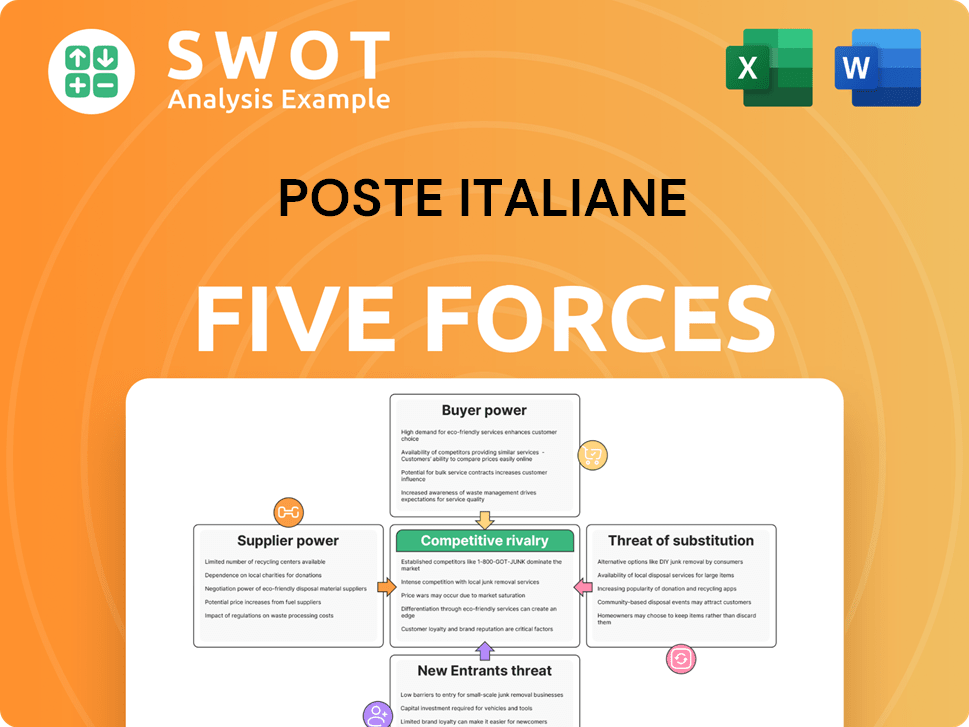
Related Blogs
- What is Competitive Landscape of Poste Italiane Company?
- What is Growth Strategy and Future Prospects of Poste Italiane Company?
- How Does Poste Italiane Company Work?
- What is Sales and Marketing Strategy of Poste Italiane Company?
- What is Brief History of Poste Italiane Company?
- Who Owns Poste Italiane Company?
- What is Customer Demographics and Target Market of Poste Italiane Company?
Disclaimer
All information, articles, and product details provided on this website are for general informational and educational purposes only. We do not claim any ownership over, nor do we intend to infringe upon, any trademarks, copyrights, logos, brand names, or other intellectual property mentioned or depicted on this site. Such intellectual property remains the property of its respective owners, and any references here are made solely for identification or informational purposes, without implying any affiliation, endorsement, or partnership.
We make no representations or warranties, express or implied, regarding the accuracy, completeness, or suitability of any content or products presented. Nothing on this website should be construed as legal, tax, investment, financial, medical, or other professional advice. In addition, no part of this site—including articles or product references—constitutes a solicitation, recommendation, endorsement, advertisement, or offer to buy or sell any securities, franchises, or other financial instruments, particularly in jurisdictions where such activity would be unlawful.
All content is of a general nature and may not address the specific circumstances of any individual or entity. It is not a substitute for professional advice or services. Any actions you take based on the information provided here are strictly at your own risk. You accept full responsibility for any decisions or outcomes arising from your use of this website and agree to release us from any liability in connection with your use of, or reliance upon, the content or products found herein.